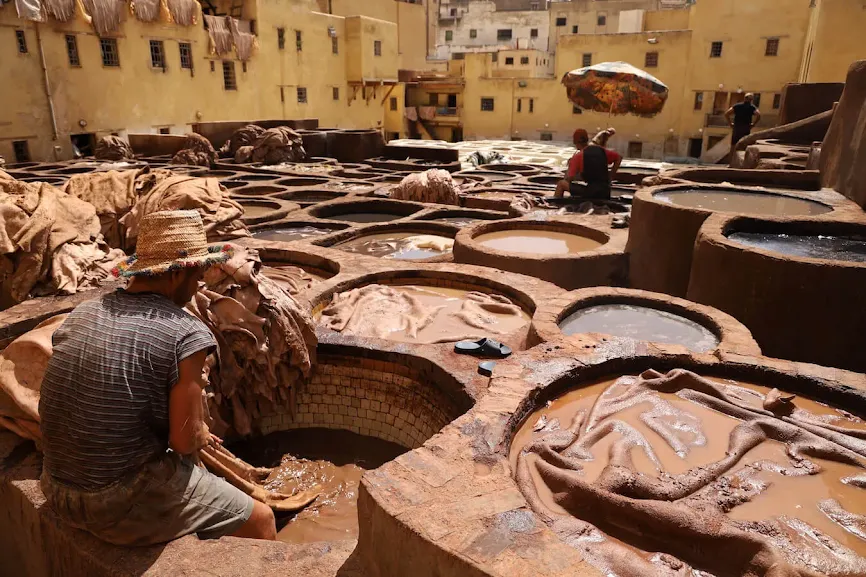History of Tanneries in Marrakech
The story of leather in Morocco dates back over a thousand years. Marrakech, one of the country’s imperial cities, has long been a hub of craftsmanship, trade, and artistic expression. The art of tanning hides and crafting fine leather goods was brought by early Berber and Arab settlers and perfected through generations. Traditional tanning methods have been passed down like family heirlooms, and many of the techniques used today remain unchanged from medieval times.
Tanning in Marrakech is more than a trade; it is a ritual deeply ingrained in local life. Using natural agents such as lime, pigeon droppings, and various plant extracts, artisans transform raw animal hides into supple, richly colored leather. These materials, while unusual to outsiders, are part of the secret to Morocco’s globally renowned leather quality. The process is tough, messy, and labor-intensive, but the end result is unmatched — supple bags, vibrant slippers, and beautifully handcrafted poufs that decorate homes worldwide.
Marrakech's leather-making tradition is centered around its old medina, particularly the area near Bab Debbagh ("Gate of the Tanners"). Here, age-old stone vats bubble with dyes, and artisans in knee-deep pits work hides under the intense North African sun. The visual drama of the tanneries makes them a photographer’s dream, but it’s the history soaked into every wall and walkway that truly captivates.
What to Expect When Visiting a Tannery
The moment you approach a tannery, your senses will awaken. The strong, unmistakable scent of raw animal hide and ammonia hits first. Visitors are often handed a sprig of mint to hold under their noses — a small mercy that makes the smell more tolerable. Then comes the sight: rows of open-air stone pits, each filled with dyes in earthy reds, yellows, and blues. Workers, often barefoot or wearing rubber boots, submerge hides and stir the contents with wooden paddles or their own hands and feet.
You may witness different stages of the tanning process, from soaking and cleaning the raw hides, to dyeing and drying them under the sun. It’s a gritty, raw, and honest environment. The atmosphere is busy but not chaotic, with a rhythm and order that reflect centuries of experience.
Expect informal tours by locals who will explain the process, sometimes in French, Arabic, or broken English. While these impromptu guides can be insightful, they often expect a tip or will try to funnel you into a leather shop afterward. Always agree on a price for the tour upfront, or politely decline if you're not interested.
Where Are the Best Tanneries in Marrakech?
The best-known tanneries in Marrakech are found in the Bab Debbagh district, located at the eastern end of the medina. This area has hosted tanners since the 11th century and remains the epicenter of leather production in the city. Though smaller and less colorful than the tanneries in Fes, Marrakech’s workshops offer a more intimate and accessible look at this ancient art.
One of the most famous locations is the Tanneries de Bab Debbagh, a cluster of interconnected dye pits and workshops. It’s an active production site, not just a tourist display, which makes it all the more authentic. Many buildings around the pits have balconies or rooftops that offer a bird’s-eye view — often accessible if you purchase something or tip the guide.
For a quieter but equally authentic experience, explore the smaller tanneries nearby or visit in the morning when the sun lights up the dye vats and the activity is at its peak. Use Google Maps or ask trusted locals to guide you through the maze-like alleys. Remember, signs can be scarce, and some locals may mislead you for a commission.
Guided Tours vs. Going Solo
While it’s entirely possible to explore the tanneries on your own, many travelers prefer a guided experience. Local guides can provide historical context, explain each step of the tanning process, and help you avoid common scams. Platforms like Airbnb Experiences or Viator offer vetted tours that include hotel pickup, translation services, and shopping tips.
The main advantage of a guide is access: they can lead you to rooftops, hidden courtyards, and family-owned shops that are otherwise difficult to find. However, the downside can be pressure to buy products or tip heavily. Always check reviews before booking and clarify what's included.
Going solo offers more freedom and may be more budget-friendly, but it also requires a good sense of direction and assertiveness. If you're exploring independently, be cautious of unsolicited offers for help and avoid following strangers into shops.
Leather Shopping in the Medina: What to Buy and Where
No tannery visit is complete without a bit of shopping. Marrakech is famous for its leather goods, and the souks near the tanneries are filled with handcrafted treasures. From soft leather slippers (babouches) to intricately stitched handbags, wallets, belts, and furniture pieces, there is something for every taste and budget.
To ensure you're buying quality leather:
Smell the item: real leather has a distinct earthy aroma.
Touch it: genuine leather feels soft and pliable.
Check the stitching: high-quality products have neat, strong seams.
Ask about the origin: many artisans will proudly tell you how and where it was made.
Recommended shopping areas include Souk Semmarine, Souk Cherratine (known for leather), and artisan collectives around Place des Ferblantiers. These locations offer a range of prices and styles, and some shops are part of fair-trade cooperatives that support local communities.







